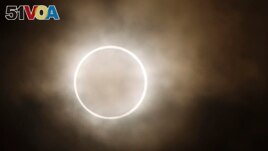25 September 2023
Millions of people in the Americas will be in a position to see a solar eclipse on October 14.
Weather permitting, viewers will be able to see the moon as it is passing in front of the sun during the eclipse. The astronomical event can be seen in parts of the United States, Mexico, and several countries in Central America and South America.
What is an annular solar eclipse?

FILE - An annular eclipse at a waterfront park in Yokohama, near Tokyo, Monday, May 21, 2012. (AP Photo/Shuji Kajiyama)
A solar eclipse happens when the moon passes between Earth and the sun. The moon blocks the view of some or all of the sun's face as it passes in front of the sun.
The one that will happen on October 14 is called an "annular solar eclipse." This happens when the moon passes between Earth and the sun at a time when the moon is at or close to its farthest point from our planet.
Because the moon is farther than usual from Earth during an annular solar eclipse, the moon will not completely cover the sun like a "total eclipse."
It will instead look like a dark circle on top of the sun's larger, bright face in the sky. As a result, the eclipse will momentarily look like a "ring of fire" surrounding the dark circle of the moon. A total eclipse will happen on April 8, 2024. It will pass over Mexico, the United States, and Canada.
Where can it be seen?
The U.S. space agency NASA says the path in the United States where the maximum amount of sun will be covered runs through several states beginning at 16:13 GMT. It will start in the state of Oregon, and then pass through California, Nevada, Utah, Arizona, New Mexico, and Texas.
The path then crosses over parts of Mexico, Guatemala, Belize, Honduras, Nicaragua, Panama, Colombia, and Brazil before ending at sunset in the Atlantic Ocean.
People in much larger parts of North America, Central America, and South America will be able to see less of the sun covered, but it is still something to witness.
What is the safest way to watch an eclipse?
Experts warn that it is unsafe to look directly at the bright sun without using specialized eye protection designed for seeing the sun. Eyes can become damaged when looking at the sun without protection.
Because the sun is never fully blocked by the moon in an annular solar eclipse, it is never safe to look directly at it without such eye protection.
Viewing it through a camera, binoculars, or telescope, without making use of a special filter for the sun can cause severe eye injury, experts say.
They advise using safe viewing glasses for the sun or a safe handheld viewer for the sun at all times during an annular solar eclipse. They note that regular sunglasses are not safe for viewing the sun.
I'm Gregory Stachel.
Will Dunham reported this story for Reuters. Gregory Stachel adapted the story for VOA Learning English.
__________________________________________________
Words in This Story
ring – n. something that is shaped like a circle
maximum – n. the highest number or amount that is possible or allowed
filter – n. a device that prevents some kinds of light, sound, or electronic noises from passing through